Tomb of General Zu Dashou

The Tomb of General Zu Dashou (also known as the "Ming Tomb") is one of the earliest pieces in the Royal Ontario Museum’s collections, and on the museum's list of Iconic Objects.[1] In the early 20th century, Charles T. Currelly, the managing director of the museum at the time, was offered a chance to purchase a number of Chinese artifacts from George Crofts, a wealthy Chinese fur trader.[2]
In 1921, the tomb and the associated artifacts arrived at the museum and became a focal point to the collection. Originally there was little provenance (or history) relating the artifacts to their long history and it was only suspected that this tomb belonged to General Zu. Research into the tomb and its history has continued over the decades. In 2005, curator Klaas Ruitenbeek’s research confirmed that the tomb was original built for and contained the remains of General Zu Dashou and his three wives.[3]
Today, the altar, stone burial mound, archway and other artifacts are arranged to replicate the burial area as it was found in Yongtai Village (near Beijing) in 1919. Other tombs in the complex suggest that this tomb was part of a family burial plot, as a number of his sons were buried near by.
General Zu Dashou
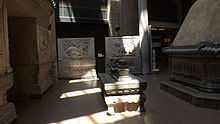
General Zu Dashou (Chinese: 祖大壽; pinyin: Zǔ Dàshòu; died 1656) bravery as a defender of the Ming dynasty earned him an esteemed place in Chinese history.[4] His story, however, is not without tragedy. In 1631, the general gave the enemy army one of his loyal sons as a hostage in hopes to speed up negotiations and relieve the people of Dalinghe of constant warfare. By the time the Ming dynasty fell in 1644, a number of the general’s sons had switched loyalties. In 1656, the exiled general died and construction on his tomb began. The scale of the tomb is an indication of respect and esteem General Zu held even amongst his enemies.
Imagery
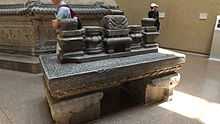
The tomb complex is full of imagery representing good fortune and immortality.[5] Like many cultures across the world, burial imagery acts as a charm for those crossing to an after life as well as serving as a visual reminder of the departed, and their good deeds, to those who remained. Family member would make offerings to their ancestors, including General Zu, several times a year. Most of these offering included ceramic tomb gifts.
Symbols in the tomb complex include:
- Deer is the symbol for longevity
- Monkeys near the bees nest is a pun for high rank.
- Qilin are mystical animals (many of the carvings represent qilin)
Other images include dragons, bamboo, and lotus flowers.
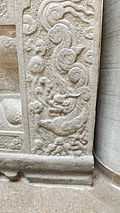 Ming Tomb archway, Royal Ontario Museum |
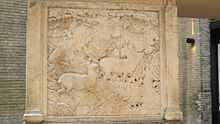 Archway, view from burial mound, Royal Ontario Museum |
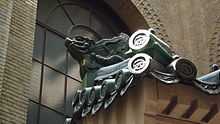 Archway, view from burial mound, Royal Ontario Museum |
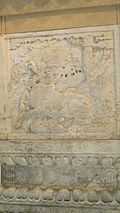 Wall carvings, Royal Ontario Museum |
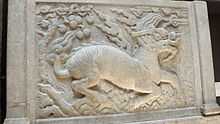 Ming Tomb exhibit, Royal Ontario Museum |
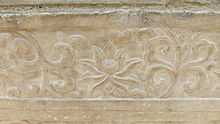 Archway carving, Royal Ontario Museum |
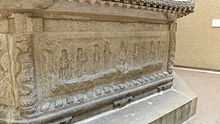 Tomb base, Royal Ontario Museum |
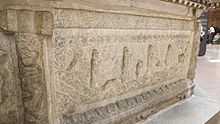 Tomb base, Royal Ontario Museum |
References
- ↑ Derksen, Tessa (2010). Iconic: The Must-See Treasure of the ROM. Toronto: Royal Ontario Museum. p. 35. ISBN 978-0-88854-473-5.
- ↑ "Toronto Feature: Royal Ontario Museum".The Canadian Encyclopedia. Retrieved 13 July 2013
- ↑ Ruitenbeek, Klaas. "Iconic: Ming Tomb". Royal Ontario Museum. Retrieved 13 July 2013.
- ↑ Ruitenbeek, Klaas."Tomb of General Zu Dashou (Ming Tomb)" The Louvre has the Mona Lisa. The British Museum, the Rosetta Stone. Herewith, 15 of the ROM's own must-see artifacts. ROM Magazine. 22 June 2008.
- ↑ Welch, Patricia Bjaaland (2008). Chinese Art: A Guide to Motifs and Visual Imagery. Tuttle Publishing . ISBN 080483864X
| ||||||||||||||